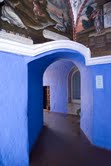Arequipa
Arequipa's territory consists of a series of stepped desert terraces at the foot of the Coast Range west of the southern Andes, reaching the level of the plateau, where some peaks rise over 6,000 meters. Among those are the Ampato to 6310 m, Chachani to 6075 m, and the Misti volcano at 5825 m in the east.
To the west stands the massive giant called Coropuna, consisting of five snowy peaks, the highest of which reaches 6425 m, and is visible from a distance.
In this region of South America, the Andes flow east to west, changing the course of the great chain and therefore the general lines of the South American coast.
PATHS
The Pan American Highway south parallels the coast for most of its course and is fully paved and in excellent condition. From Lima to Arequipa is 1009 km.
From the port of Matarani, one can also travel to Arequipa along a paved road. From Lima, there are daily flights to Alfredo Chavez Balló airport in Arequipa.
Southern Volcanic Cordillera
The Southern Andes, passing through the departments of Arequipa, Moquegua and Tacna, are known as the volcanic range. In the so-called Valley of Fire (Andagua), Colca Canyon,there are numerous craters, dormant volcanoes and thousands of tons of thick layers of solidified lava. In Moquegua, the Ubinas volcano (5672 m) is the only active volcano in Peru.
The Birth of the Amazon
The Amazon River drops from its source in two small lakes located in the province of Caylloma, at the foot of Mount Mismi, 5597 meters above sea level, at the head of the ravine Carhuasanta, part of the Cordillera de Chila.
Its origin in northern Arequipa river named Monigote-Hob, was established on October 15, 1975 during a successful expedition sponsored by the International Geodetic Survey and National Geographíc magazine.
It was determined that the above point is the origin of the Amazon River given that "the arms longer course and more flow" via the Choquequirao gaps in the Apurimac River mouth that travels together with other channels where the Cuzco joins the Mantaro River Jan and from there, then its waters pouring into the Tambo River which joins the Ucayali Atalaya.
 TEMPLES AND MONASTERIES
TEMPLES AND MONASTERIES
Arequipa, Catholic city par excellence, is perhaps one of the capital cities with the largest number of temples, monasteries and convents.
From colonial times this city has been famous for its Easter processions and other holy day celebrations.
At Easter, the devotees leave the church, preceded by salvos of rockets and fireworks. Some celebrations last from early morning until late at night. Due to the number of churches, there is no shortage of saint days or patron saints to honor with a festival.
 THE CONVENTO DE SANTA CATALINA: A Mole of Sillar
THE CONVENTO DE SANTA CATALINA: A Mole of Sillar
The Convento de Santa Catalina was founded in September 1579, after more than 20 years of effort, projects and raising money to do it.
It is one of the most important religious monuments in colonial Arequipa and it occupies an area of 20,426 m2 on the street of the same name.
Its interior, which functioned as cloistered convent until 1970, has 3 cloisters and almost a hundred sleeping dorms arranged in 6 blocks, and a passage with a central square containing a pool. Its tall walls and buttresses show various architectural styles.



